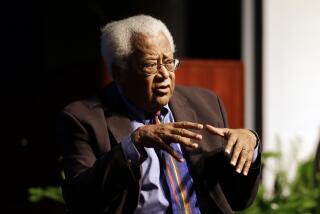UNDERSTANDING THE RIOTS--SIX MONTHS LATER : Touched by Fire / A Legacy of Pain and Hope : THE HELPERS : Doing the Right Thing in Spite of Danger, Adversity
For many Californians, the riots were more than a momentary blip on the screen--they were a flash point for lasting and fundamental changes in their lives. The devastation left a legacy of broken dreams for many, awakened a sense of social justice in some, unleashed anger and hatred in others, and rekindled a spirit of hope among others. Six months after the riots, Times reporters visited some of the people and places touched by the extraordinary events of last spring and on these pages we tell their stories.
In 1950, a young black diplomat from Watts named Ralph Bunche won the Nobel Peace Prize for helping to negotiate a temporary armistice in the fighting between Israel and Egypt.
Forty-two years later, a group of young black gang members from Watts used his work as a model to try to end another seemingly intractable conflict--the two decades of warfare between Crips and Bloods.
The research that produced the gangsâ plan for peace was the brainchild of Anthony Perry, an ex-gangbanger who spent hours in the library at USCâs Von Kleinsmid Center for International and Public Affairs in the days after the riots, in search of a blueprint to guide truce talks. He stumbled across Buncheâs United Nations treaty, and was struck by the parallels between the Mideast strife and that of his neighborhood streets.
Perry, 30, has not won a peace prize, but his efforts did draw praise from gang workers and political scientists, and earnedhim a spot as a speaker at a national gang and drug conference last monthin Alexandria, Va.
âI didnât really want the spotlight,â said Perry, carefully avoiding any comparisons with the handful of gang members who have emerged as media celebrities since the riots. âWords do nothing. It takes action and I feel the most powerful people always remain behind the scenes.â
Perryâs document, drafted in neat block letters on a yellow legal pad, put into street terms the diplomatic language of the Egyptian-Israeli General Armistice Agreement, signed on the island of Rhodes in 1949.
Where that accord banned âaggressive action by the armed forces,â the gang treaty calls for âno aggressive action by the leading influential gang members.â A reference to stopping attacks by land, sea or air was changed to a prohibition on âdrive-by shootings and random slayings.â
In the end, the document was never signed by the four principal black gangs in Watts, largely because gang leaders were concerned that their signatures could be used against them by law enforcement officers, Perry said. Still, he credits the treaty with helping to crystallize the nascent truce, which has continued to hold down gang killings in Watts, and to a lesser extent, in other sections of South-Central Los Angeles.
âThe idea is greater than any words on paper,â Perry said.
Since July, Perry has been living in Oregon, where he plans to spend the next year as a representative of the Los Angeles-based Amer-I-Can program, a self-esteem course for gang members and convicts created by former National Football League star Jim Brown.
Amer-I-Can was awarded a $319,000 contract by Oregon officials to teach Brownâs âlife-management skillsâ course to several hundred prison inmates and 30 gang officers from the Portland Police and Oregon State Police departments.
So far, Major Dean Renfrow, director of criminal investigations for the Oregon State Police, has given high marks to the progress that Perry and his crew have made in building bridges between officers and Oregonâs gang population of about 2,700.
Perry, who spends most of his time teaching the course to the inmates, said that being away from his two sons is the hardest part of his job. âThatâs the greatest struggle,â he said. âBut itâs beautiful up here--the land, the trees, everything green, itâs like the ideal place.â
More to Read
Sign up for Essential California
The most important California stories and recommendations in your inbox every morning.
You may occasionally receive promotional content from the Los Angeles Times.










